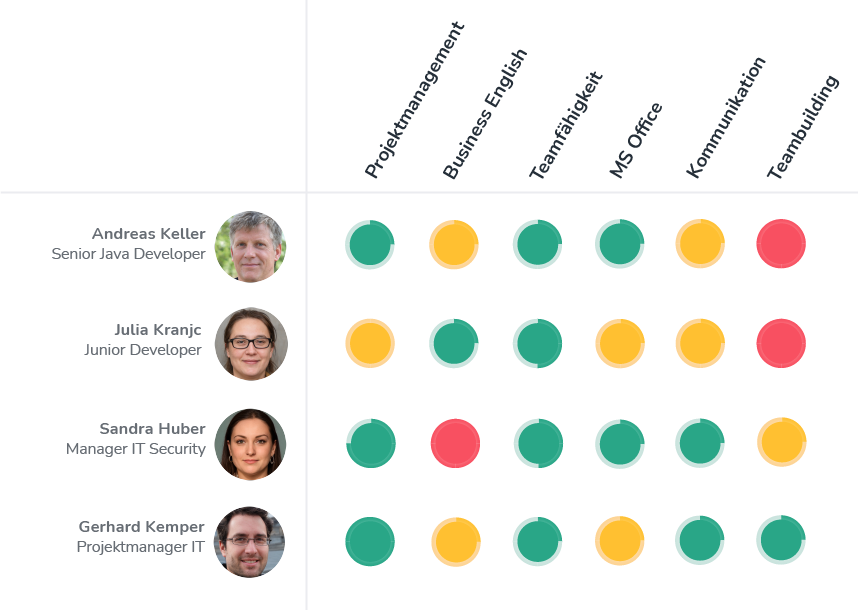Organizations have employees with a wide variety of skills. The Skill Matrix is an easy way to make these abilities visible. It is a valuable tool to indicate the capabilities of employees within the organization or department. In doing so, it lists existing and missing capabilities and thus supports business-relevant decisions.
In this article, we will show what a skill matrix is and how it can be built. An example of a skill matrix is also given and explained.
Content
What is a skill matrix?
Basically, the skills matrix is a tool for visualizing needed and available skills within an organization, team, or individual. It also helps to evaluate how well a person with the given skills is qualified for a job or how well a team is equipped for a new challenge. For this reason, it is also called a competence matrix, simply because it indicates the competence of a person or a team. This makes it an indispensable tool for any data-driven HR professional.
Field of application and usage
As mentioned before, skill matrices have the primary task of making the qualifications of employees visible. But what are the benefits for organizations?
Creating an overview
On the one hand, skill matrices help to get to know one’s own organization better. It provides a clear overview of an organization’s needed and existing capabilities. In its simplest form, this identifies and lists all the skills available in the organization and links them to the appropriate employees. This results in an overview of all existing employees and the associated skills, which can be easily interpreted.
Planning and decision making
The information to be extracted from the skill matrix serves as the basis for decision-making. These decisions can take place in a wide variety of areas of the organization, such as resource deployment planning, workforce planning, or budget planning. Managers and executives thus have data-supported arguments to underpin plans and to be able to carry out planning more effectively.
Structure
There are no universal guidelines regarding the structure and complexity of a skill matrix. When creating a matrix, each organization can have different approaches. Some take a very simple (binary) approach, while others have a very detailed (360° capability analysis) approach. Whichever way is chosen, at the end of the creation a holistic view of the available and the retarded capabilities is possible. It should also be clearly distinguished from a competency matrix. The difference to the competence matrix is that in skill matrices only skills are considered and expertise and behaviour are left out.
In the previous article of the guide, different competency models were presented. Here we mention the most commonly used models to build a skill matrix.
- Binary system. In this system, skills are evaluated based only on two criteria. (qualified / not qualified)
- Skill-Will Matrix. This matrix is divided into four quadrants. Depending on the combination of ability and willingness to perform a task, individuals are assigned to one of the quadrants of the matrix.
- 360° Capability Analysis. In this system, the evaluation is done on a scale of 10, 100, 360 degrees. 360 degrees refers to an evaluation by all involved entities of an organization – from the department head to the peer review of the employees.
Example of a skill matrix
The skill matrix below is structured in the style of a 360° capability analysis. It contains information about employees from the IT department. This information was entered by the employees themselves and validated by department heads or managers. The coloured circles show whether employees fulfil a skill (colour) and to what degree (edge of the circles).
The matrix shows that skill matrices can be easily constructed and can provide valuable information. If this information is used correctly, efficiency in the company can be greatly increased – whether in the area of resource deployment planning, personnel planning or budget planning. In addition, workers can be properly deployed, the right further education and training can be planned at the right times and successors for certain positions can be found quickly.

If you want to get started with skills management in your organization and build your own skills matrix in Excel, read our post on skills management in Excel or download our skills matrix template in Excel.
